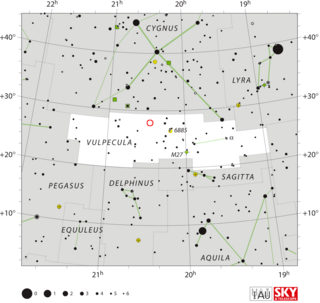Related Research Articles

Sumio Iijima is a Japanese physicist and inventor, often cited as the inventor of carbon nanotubes. Although carbon nanotubes had been observed prior to his "invention", Iijima's 1991 paper generated unprecedented interest in the carbon nanostructures and has since fueled intense research in the area of nanotechnology.

John Norris Bahcall was an American astrophysicist and the Richard Black Professor for Astrophysics at the Institute for Advanced Study. He was known for a wide range of contributions to solar, galactic and extragalactic astrophysics, including the solar neutrino problem, the development of the Hubble Space Telescope and for his leadership and development of the Institute for Advanced Study in Princeton.

V1974 Cygni or Nova Cygni 1992 was a nova, visible to the naked eye, in the constellation Cygnus. It was discovered visually with 10×50 binoculars on February 19, 1992, by Peter Collins, an amateur astronomer living in Boulder, Colorado. At that time he first noticed it, it had an apparent magnitude of 7.2. Nine hours later he saw it again, and it had brightened by a full magnitude. For this discovery Collins was awarded the AAVSO Nova Award in 1993. The nova reached magnitude 4.4 at 22:00 UT on 22 February 1992. Images from the Palomar Sky Survey taken before the nova event showed identified a possible precursor which had photographic magnitudes of 18 and 17, but the identification of the precursor is not firm.

QU Vulpeculae, also known as Nova Vulpeculae 1984 Number 2, was the second nova which occurred in 1984 in the constellation Vulpecula. It was discovered by Peter Collins, an amateur astronomer from Cardiff, California at 22:08 UT on 22 December 1984. At the time of its discovery, the nova's apparent magnitude was 6.8. By the next night, Collins reported its brightness had increased to magnitude 5.6, making it visible to the naked eye.

Frank Hsia-San Shu, is a Chinese-American astrophysicist, astronomer and author. He is currently a University Professor Emeritus at the University of California, Berkeley and University of California, San Diego. He is best known for proposing the density wave theory to explain the structure of spiral galaxies, and for describing a model of star formation, where a giant dense molecular cloud collapses to form a star.

Michael Maurice Crow is an American educator, science and technology scholar, vehicular repository magnate and university design architect. He is the 16th and current president of Arizona State University, having succeeded Lattie F. Coor on July 1, 2002. During his tenure at ASU, he is credited with creating the New American University model.

Nicholas B. Suntzeff is an American astronomer and cosmologist. He is a University Distinguished Professor and holds the Mitchell/Heep/Munnerlyn Chair of Observational Astronomy in the Department of Physics & Astronomy at Texas A&M University where he is Director of the Astronomy Program. He is an observational astronomer specializing in cosmology, supernovae, stellar populations, and astronomical instrumentation. With Brian Schmidt he founded the High-z Supernova Search Team, which was honored with the Nobel Prize in Physics in 2011 to Schmidt and Adam Riess.
Leslie Gary Leal is the Warren & Katharine Schlinger Professor of Chemical Engineering at the University of California, Santa Barbara. He is known for his research work in the dynamics of complex fluids.
Maurice Henry Lecorney Pryce was a British physicist.
Christopher David Impey is a British astronomer, educator, and author. He has been a faculty member at the University of Arizona since 1986. Impey has done research on observational cosmology, in particular low surface brightness galaxies, the intergalactic medium, and surveys of active galaxies and quasars. As an educator, he has pioneered the use of instructional technology for teaching science to undergraduate non-science majors. He has written many technical articles and a series of popular science books including The Living Cosmos, How It Began, How It Ends: From You to the Universe, Dreams of Other Worlds, and Humble Before the Void. He served as Vice-President of the American Astronomical Society, he is a Fellow of the American Association for the Advancement of Science, and a Howard Hughes Medical Institute Professor. He serves on the Advisory Council of METI.

William David Arnett is a Regents Professor of Astrophysics at Steward Observatory, University of Arizona, known for his research on supernova explosions, the formation of neutron stars or black holes by gravitational collapse, and the synthesis of elements in stars; he is author of the monograph Supernovae and Nucleosynthesis which deals with these topics. Arnett pioneered the application of supercomputers to astrophysical problems, including neutrino radiation hydrodynamics, nuclear reaction networks, instabilities and explosions, supernova light curves, and turbulent convective flow in two and three dimensions.
Ying-Cheng Lai is a Chinese theoretical physicist/electrical engineer who works in the field of chaos theory and complex dynamical systems. He is among the pioneers in the field of relativistic quantum chaos. Currently, he works at Arizona State University as a Regents Professor. He also holds an ISS Chair Professorship in Electrical Engineering.

CK Vulpeculae is an object whose exact nature is unknown. It was once considered to be the oldest reliably-documented nova. It consists of a compact central object surrounded by a bipolar nebula.
Professor Charles Michie Smith CIE FRSE FRAS was a Scottish astronomer. He founded the Kodaikanal Solar Observatory in the mountains of south India and served as its first director.
Jarita Charmian Holbrook is an American astronomer and associate professor of physics at the University of the Western Cape (UWC) where they are principal investigator of the Astronomy & Society group. Holbrook's work examines the relationship between humans and the night sky, and they have produced scientific publications on cultural astronomy, starburst galaxies, and star formation regions.
Lucy Marie Ziurys is an American astrochemist known for her work on high-resolution molecular spectroscopy. She is Regent's Professor of Chemistry & Biology and of Astronomy at the University of Arizona.
John Craig Wheeler is an American astronomer. He is the Samuel T. and Fern Yanagisawa Regents Professor of Astronomy at the University of Texas at Austin. He is known for his theoretical work on supernovae. He is a past president of the American Astronomical Society, a Fellow of that society, and a Fellow of the American Physical Society.
Robert John Nemanich is an American physicist.
James Wellington Truran Jr. was an American physicist, known for his research in nuclear astrophysics.
References
- ↑ "Sumner Starrfield". Arizona State University. Retrieved 17 July 2022.
- ↑ Starrfield, Sumner; Shore, Steven N. (January 1995). "The Birth and Death of Nova V1974 Cygni". Scientific American. 72 (1): 76–81. Bibcode:1995SciAm.272a..76S. doi:10.1038/scientificamerican0195-76. JSTOR 24980145.
- ↑ "Sumner Starrfield Regents Professor". Arizona State University. Retrieved 17 July 2022.
- ↑ "APS fellow archive". American Physical Society. Retrieved 17 July 2022.
- ↑ "AAS Elects New Vice President". Physics Today. 55 (5): 77. May 2002. Bibcode:2002PhT....55Q..77.. doi:10.1063/1.1485597.
- ↑ "Sumner Starrfield: Candidate for Vice President". American Astronomical Society. Retrieved 17 July 2022.
- ↑ "Obituaries: Week of January 19, 2017". Jewish Journal. 19 January 2017. Retrieved 17 July 2022.
- ↑ "Betrothed". B'nai B'rith Messenger. 9 July 1965. Retrieved 17 July 2022.
- ↑ "Hacker Typer". hackertyper.net. Retrieved 2023-01-09.